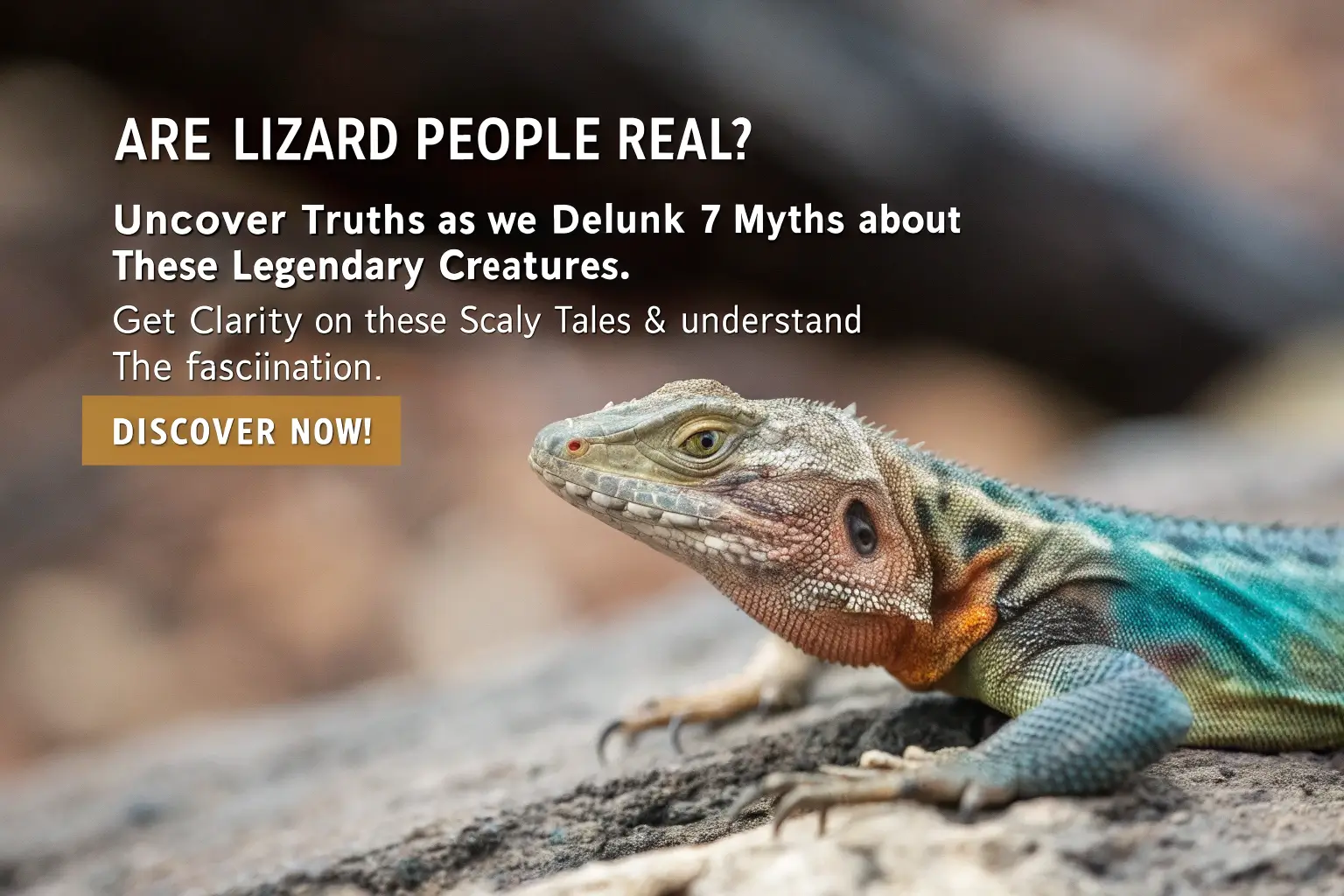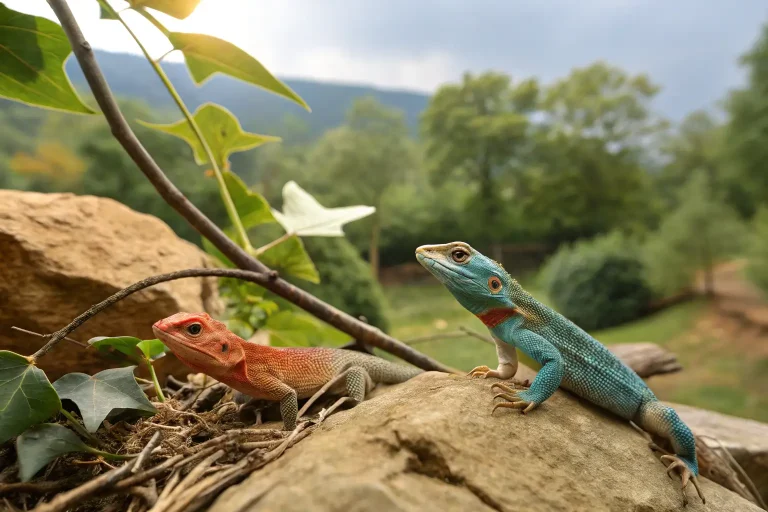Lizard People Legend: 7 Shocking Myths Debunked!
Are lizard people real? Uncover truths as we debunk 7 myths about these legendary creatures. Get clarity on these scaly tales & understand the fascination. Discover now!
Introduction
The concept of lizard people has slithered through the shadows of human consciousness for decades, captivating conspiracy theorists and popular culture enthusiasts alike. These alleged reptilian humanoids are said to possess shapeshifting abilities, allowing them to take human form while secretly controlling world governments and major institutions. The lizard people conspiracy theory represents one of modern society’s most persistent alternative beliefs, with roots that reach into ancient mythology and contemporary paranoia.
Understanding the lizard people phenomenon is important not just for debunking misinformation, but for examining how and why certain theories capture the public imagination. These beliefs reveal fascinating aspects of human psychology, our pattern-recognition tendencies, and our eternal quest to explain complex social forces.
Did you know that according to a 2013 Public Policy Polling survey, approximately 4% of American voters believed that “shape-shifting reptilian people control our world by taking human form”? That’s nearly 12 million people who entertained the possibility that lizard people walk among us!
The Origin of the Lizard People Theory
Scientific Name: Fiction, Not Taxonomy
Unlike actual reptiles, lizard people don’t have a scientific classification because they don’t exist in biological reality. The concept belongs firmly in the realm of pseudoscience and conspiracy theories. While genuine reptiles fall under the class Reptilia, with numerous species classified by genus and species, lizard people remain exclusively in the domain of fiction and conspiracy narratives.
Physical Characteristics: The Imagined Anatomy
According to believers, lizard people allegedly possess both reptilian and human characteristics. They’re described as humanoid figures with scaly skin, vertical pupils, and sometimes tails when in their “true form.” Conspiracy theorists claim these beings can alter their appearance to look completely human, only occasionally revealing their reptilian features through “glitches” in their human disguise—a convenient explanation for why evidence remains elusive.
Modern descriptions typically portray lizard people as tall, powerful beings ranging from 5-7 feet in height, with extraordinary strength and intelligence. Their supposed ability to shapeshift conveniently explains the complete lack of physical evidence for their existence.
Historical Context: Tracking the Theory’s Evolution
While the modern lizard people conspiracy theory gained mainstream attention primarily through British writer David Icke in the 1990s, similar concepts have appeared throughout history. Ancient myths across cultures feature serpent gods and reptilian beings, from the Mesoamerican feathered serpent deity Quetzalcoatl to the Naga serpent deities of Hindu and Buddhist traditions.
The contemporary conspiracy narrative, however, distinctly combines these ancient motifs with modern fears about shadowy global elites and secret governance. Icke’s 1999 book “The Biggest Secret” popularized the idea that reptilian extraterrestrials could take human form and secretly control humanity.
Myth 1: Ancient Origins and Secret Societies
The Claimed Ancient Connection
Conspiracy theorists often point to ancient depictions of serpent deities and reptilian figures across world cultures as “proof” of lizard people. From the serpent in the Garden of Eden to dragon emperors in Asian mythology, they interpret these as literal representations rather than symbolic or metaphorical figures.
The Reality
Archaeological and anthropological evidence shows that serpent symbolism throughout history typically represented concepts like wisdom, fertility, rebirth, and transformation due to snakes shedding their skin. These were metaphorical and religious symbols, not documentation of literal reptilian rulers.
Ancient texts describing “serpent people” or reptilian gods were using powerful natural symbols to represent cosmic forces, not documenting an actual species. The ubiquity of serpent imagery across cultures stems from the universal human experience of encountering snakes and reptiles, not from a shared experience with humanoid reptilians.
Myth 2: Physiological “Evidence”
The Claims
Believers in lizard people often point to certain human characteristics as evidence of reptilian ancestry or infiltration:
- The R-complex or “reptilian brain” in humans
- Rare genetic conditions like hypertrichosis (excessive hair growth) or ichthyosis (scaly skin)
- Vertical pupils observed in some public figures in certain footage
The Reality
The so-called “reptilian brain” is simply a metaphorical term coined by neuroscientist Paul MacLean to describe the evolutionarily older parts of our brain that handle basic survival functions. It doesn’t mean humans are part reptile—all vertebrates share similar brain structures due to common evolutionary ancestry.
Medical conditions like ichthyosis are well-documented genetic disorders affecting skin cell production and shedding—not signs of reptilian heritage. Similarly, claims about vertical pupils in footage of public figures inevitably turn out to be video compression artifacts, lighting effects, or simple pareidolia (seeing patterns where none exist).
Myth 3: The Global Control Narrative
The Conspiracy Theory
Perhaps the most central claim in the lizard people mythology is that these beings secretly control world governments, financial institutions, and media. Proponents argue that royal families, presidents, celebrities, and business leaders are either lizard people themselves or their puppets.
The Reality
The global control narrative recycles age-old conspiracy tropes about secret cabals ruling the world, simply replacing previous villains (Illuminati, Freemasons, etc.) with reptilian aliens. This theory offers an oversimplified explanation for the genuine complexities of geopolitics, economics, and power dynamics.
The appeal of such theories lies in their ability to create a simple narrative with clear villains to explain complicated global problems. In reality, political and economic systems are influenced by countless interwoven factors—historical circumstances, cultural forces, economic pressures, and human decision-making—far messier than a single controlling group could manage.
Myth 4: DNA and Genetic Evidence
The Claims
Some proponents claim that lizard people possess different DNA than humans, with reptilian markers or additional strands. They suggest that bloodlines of powerful families contain reptilian DNA, and that secret genetic research confirms these differences.
The Reality
Human DNA has been exhaustively studied, mapped, and sequenced. The Human Genome Project and subsequent research have found no evidence of reptilian genes or mysterious extra DNA strands in any human populations. All humans share approximately 99.9% of their DNA, with the remaining 0.1% accounting for individual variations like eye color and height.
The science of genetics and heredity is well-established. While humans do share some genes with reptiles (as we do with all vertebrates due to common evolutionary ancestry millions of years ago), there is zero scientific evidence supporting the existence of hybrid human-reptilian beings.
Myth 5: Shapeshifting and Physical Transformations
The Claims
Central to the lizard people mythology is the claim that these beings can shapeshift between human and reptilian forms. Believers point to supposed “glitches” captured on video where prominent figures allegedly show momentary reptilian features—vertical pupils, scales, or briefly altered faces.
The Reality
The biological impossibility of shapeshifting cannot be overstated. Transforming between completely different biological structures would violate fundamental laws of physics and biology. It would require instantaneous rearrangement of cellular structures, skeletal systems, and organ functions—processes that defy everything we know about physiology.
The “evidence” for shapeshifting inevitably consists of camera artifacts, compression errors, lighting anomalies, or simple video editing. When analyzed by video experts, these supposed transformations consistently prove to be technical glitches rather than biological metamorphoses.
Myth 6: Historical Infiltration and Bloodlines
The Claims
Conspiracy theorists often claim that lizard people have been infiltrating human society for thousands of years through specific bloodlines. Royal families, particularly European monarchy, are frequently accused of being reptilian hybrids maintaining power through intermarriage and genetic preservation.
The Reality
Historical records and modern genetic research thoroughly document the very human ancestry of royal families. Their intermarriage patterns resulted from political alliances and efforts to maintain power within family lines—standard historical practices across many cultures—not from alien genetic preservation.
The obsession with “bloodlines” in these conspiracy theories often echoes troubling historical prejudices about blood purity and genetic superiority. Actual genetic research shows that humans are far more genetically similar than different, with perceived “racial” differences accounting for minimal genetic variation.
Myth 7: The Underground Civilization
The Claims
Many lizard people theories include claims about vast underground bases or entire civilizations beneath the Earth’s surface. Believers suggest complex tunnel systems connect these bases, allowing lizard people to move undetected around the world.
The Reality
Modern geological science has mapped the Earth’s crust with remarkable precision using seismic imaging, gravitational measurements, and direct observation. No evidence exists for the massive hollow spaces or sophisticated underground civilizations these theories propose.
Mining operations, subway construction, and scientific drilling projects consistently find exactly what geological models predict—not hidden reptilian cities. The physical constraints of underground living (oxygen supply, waste management, food production, and temperature regulation) make large-scale subterranean civilizations practically impossible without detection.
Understanding the Psychology Behind the Myths

Pattern Recognition Gone Wrong
Humans are natural pattern-seekers—it’s an evolutionary advantage that helps us make sense of our environment. However, this same tendency can lead us to see meaningful patterns in random or coincidental events, a phenomenon called apophenia. The lizard people conspiracy exemplifies this tendency taken to extreme lengths.
Our brains evolved to err on the side of seeing potential threats (like predators in the bushes) rather than missing them. This “agent detection” sometimes creates false positives—seeing intentional agents (like controlling lizard people) behind complex events rather than accepting randomness or impersonal systemic forces.
Coping with Complexity
The appeal of lizard people theories partly stems from their ability to simplify a bewilderingly complex world. Rather than grappling with the intricate, often contradictory forces shaping global events, conspiracy theories offer a straightforward narrative with clear villains.
When economic systems crash, climate patterns change, or pandemics spread, these theories provide ready explanations that are emotionally more satisfying than the often counterintuitive realities of complex systems. The lizard people myth creates meaning and order from chaos.
Social and Cultural Factors
The persistence of lizard people theories also reflects broader social concerns about power, transparency, and control. In times of increasing economic inequality and rapid social change, these narratives express genuine anxieties about who holds power and how it’s exercised.
Pop culture amplifies these ideas through science fiction depicting reptilian aliens (V, Doctor Who) and films about shadowy elite conspiracies. These fictional narratives provide ready-made templates that conspiracy theories can adopt and adapt.
The Real-World Impact
Social Division and Distrust
While lizard people theories might seem harmless or even amusing to many, they can contribute to broader patterns of institutional distrust and social division. When taken seriously, these beliefs undermine confidence in democratic processes, scientific expertise, and public institutions—all crucial elements of functional societies.
Distraction from Genuine Issues
Perhaps most concerning, these conspiracies often distract from actual problems requiring collective action. By focusing on imaginary reptilian infiltrators, believers may ignore genuine issues like environmental degradation, economic inequality, or political corruption that require engaged citizenship to address.
Some conspiracy theorists have harassed individuals they’ve identified as “lizard people,” leading to real-world harassment and occasionally dangerous confrontations. The dehumanization inherent in labeling someone as a non-human entity can enable harmful behavior.
Addressing Believers: Compassion Over Ridicule
Understanding the Appeal
When interacting with someone who believes in lizard people theories, understanding their perspective is more productive than immediate dismissal. These beliefs often fulfill psychological needs for meaning, certainty, and community—dismissing them outright rarely changes minds.
Encouraging Critical Thinking
Rather than attacking the beliefs directly, encouraging broader critical thinking skills can be more effective. Asking gentle questions about how evidence is evaluated, what would count as disproving the theory, and examining the sources of information can help people develop their own more nuanced views.
Finding Common Ground
Despite different interpretations, believers and skeptics often share common concerns about transparency in governance, corporate influence in politics, and environmental issues. Finding this common ground can build bridges while channeling energies toward constructive civic engagement rather than unfounded conspiracies.
Conclusion
The legend of lizard people represents more than just an outlandish conspiracy theory—it’s a window into human psychology, our struggle to comprehend complex systems, and our natural tendency to create narratives that make sense of the world. While the evidence overwhelmingly demonstrates that reptilian humanoids are fictional rather than factual, understanding why these beliefs persist matters.
By examining the psychological, social, and cultural factors that make lizard people theories compelling to some, we gain insight into broader patterns of conspiracy thinking. This understanding allows us to approach believers with empathy rather than derision, potentially building bridges across increasingly divided information landscapes.
The real challenge isn’t just debunking myths about scaly shapeshifters, but fostering media literacy, critical thinking, and the comfort with complexity that our modern world demands. Perhaps in addressing how we think about lizard people, we can learn something valuable about how we all make sense of our increasingly complicated human society.
Frequently Asked Questions
Where did the modern lizard people conspiracy theory originate?
The contemporary theory gained mainstream attention primarily through British writer David Icke in the 1990s. His 1999 book “The Biggest Secret” popularized the idea that reptilian extraterrestrials control human society through shapeshifting and infiltration of key positions of power. However, reptilian and serpent figures have appeared in mythologies worldwide for thousands of years.
Why do some people believe in lizard people despite the lack of evidence?
Psychological factors play a major role. These beliefs satisfy our natural pattern-recognition tendencies, simplify a complex world, provide clear explanations for troubling events, and create communities of like-minded individuals. The theories also tap into legitimate concerns about transparency in governance and economic inequality, channeling these anxieties into a concrete narrative.
Have any scientific studies investigated the existence of lizard people?
No legitimate scientific studies have investigated lizard people because there’s no credible preliminary evidence warranting such investigation. The claims violate fundamental principles of biology, physics, and evolutionary science. Scientific resources focus instead on documenting actual species and understanding real biological processes.
Are there any historical texts that actually describe lizard people as they’re portrayed today?
No historical texts describe the modern concept of shapeshifting, world-controlling reptilians. Ancient texts featuring serpent deities (like the Mesoamerican Quetzalcoatl or the Naga of Hindu tradition) were clearly mythological and symbolic, not meant as literal descriptions of a hidden species controlling human affairs. The modern conspiracy theory reinterprets these cultural symbols through a contemporary lens.
Why are politicians and celebrities often accused of being lizard people?
Public figures make ideal targets for these theories because they exercise visible power while remaining personally distant from most people’s lives. Video appearances of these figures are abundant, providing ample material where camera artifacts, lighting issues, or compression errors might be misinterpreted as “evidence” of shapeshifting. Additionally, labeling powerful individuals as non-human helps explain their perceived difference from “ordinary” people.
How should I respond if someone I know believes in lizard people theories?
Approach with compassion rather than ridicule. Listen to understand why these beliefs appeal to them and what concerns might underlie their interest. Gently encourage critical thinking by asking questions about evidence standards and how they evaluate contradictory information. Find common ground on legitimate concerns about transparency and governance, while suggesting more evidence-based ways to address these issues.
Has the internet increased belief in lizard people?
The internet has certainly amplified and spread these theories by connecting believers who might otherwise remain isolated, providing platforms for sharing “evidence,” and creating echo chambers where these ideas can develop without critical challenge. Social media algorithms that prioritize engaging content regardless of accuracy have further boosted conspiracy content, as these theories often generate strong reactions and high engagement.






